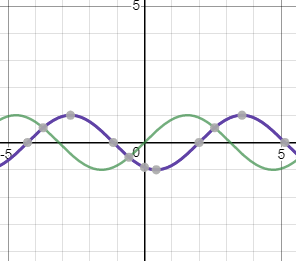
What is meant by phase angle?
Answer
219.6k+ views
Hint: Here, we have to understand the meaning of the term phase angle. In basic Physics, phase angle is used in terms of firstly, wave motion and secondly, for describing alternating current and voltage. We will discuss in terms of both the concepts. Basically, it represents angular shifts or displacements corresponding to two points having the same value along the y-axis.
Complete step by step solution:
Graphically understanding, phase angle is the angular displacement of a point on a sinusoidal wave from a reference point or time. Both waves and alternating quantities are expressed in the form of waves. So, the term is used in both ways.
In electrical quantities, alternating current as voltage are expressed as sinusoids. In waves, amplitude, velocity and acceleration of particles have alternating values and hence are expressed as sinusoids.
In an electrical circuit, we can recognize angle between resistive current and total current on phasor diagram as current phase angle(Φ)

The difference in two quantities have the same frequency and two corresponding points attain maximum value or zero value at two different instants, then the angle between two alternating quantities is called difference of phase angles. Below is the explanation of phase angle in terms of waves.

ΔΦ represents phase difference
For the purple graph, ΔΦ is the phase angle.
Note: Phase angle for any quantitative angle can be defined as the angle at the instant at which it attains zero value measured taking origin as reference. It can also be defined as the angle between total current and resistive current in an electrical circuit. If the phase angle in any phasor diagram is counter clockwise, it is taken as positive and negative for clockwise direction.
Complete step by step solution:
Graphically understanding, phase angle is the angular displacement of a point on a sinusoidal wave from a reference point or time. Both waves and alternating quantities are expressed in the form of waves. So, the term is used in both ways.
In electrical quantities, alternating current as voltage are expressed as sinusoids. In waves, amplitude, velocity and acceleration of particles have alternating values and hence are expressed as sinusoids.
In an electrical circuit, we can recognize angle between resistive current and total current on phasor diagram as current phase angle(Φ)

The difference in two quantities have the same frequency and two corresponding points attain maximum value or zero value at two different instants, then the angle between two alternating quantities is called difference of phase angles. Below is the explanation of phase angle in terms of waves.

ΔΦ represents phase difference
For the purple graph, ΔΦ is the phase angle.
Note: Phase angle for any quantitative angle can be defined as the angle at the instant at which it attains zero value measured taking origin as reference. It can also be defined as the angle between total current and resistive current in an electrical circuit. If the phase angle in any phasor diagram is counter clockwise, it is taken as positive and negative for clockwise direction.
Recently Updated Pages
Displacement and Velocity Time Graphs Explained

Clemmensen and Wolff Kishner Reductions: Mechanisms & Differences

Free Radical Substitution Mechanism: Steps & Examples for JEE/NEET

Average and RMS Value Explained: Formulas & Examples

JEE Main Candidate Login 2026 and Registration Portal | Form Access

Charging and Discharging of a Capacitor Explained Simply

Trending doubts
JEE Main 2026: Application Form Open, Exam Dates, Syllabus, Eligibility & Question Papers

Understanding Uniform Acceleration in Physics

Derivation of Equation of Trajectory Explained for Students

Hybridisation in Chemistry – Concept, Types & Applications

Understanding the Angle of Deviation in a Prism

Understanding Collisions: Types and Examples for Students

Other Pages
JEE Advanced Marks vs Ranks 2025: Understanding Category-wise Qualifying Marks and Previous Year Cut-offs

Understanding Atomic Structure for Beginners

How to Convert a Galvanometer into an Ammeter or Voltmeter

Understanding Centrifugal Force in Physics

JEE Main Marking Scheme 2026- Paper-Wise Marks Distribution and Negative Marking Details

Degree of Dissociation: Meaning, Formula, Calculation & Uses




